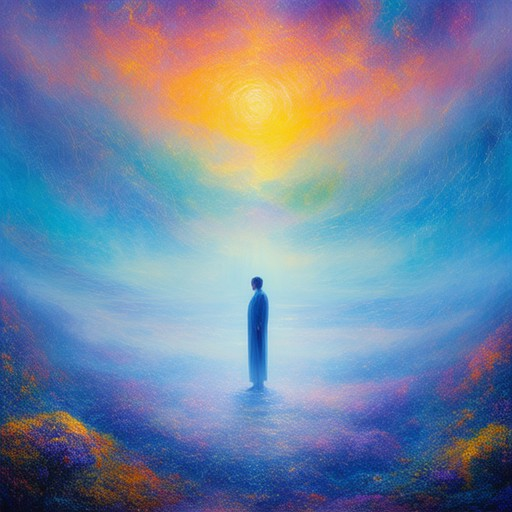The pursuit of self-realization is a universal journey that has captivated thinkers, mystics, and seekers across generations. Through diverse stories, we explore the multifaceted paths, profound experiences, and symbolic representations that define this transformative quest. This article delves into the intricate details of self-realization, examining its various facets and offering insights into how individuals navigate this profound journey. By uncovering the stories behind self-realization, we aim to provide a comprehensive understanding of the experiences, theories, and signs that guide us toward self-discovery. Whether you are a novice or a seasoned traveler on this path, this exploration will shed light on the symbols, steps, and emotions that accompany the journey toward self-realization.

What Are the Four Paths of Self-Realization?
The journey toward self-realization can be approached through various spiritual and philosophical paths, each offering unique perspectives and practices. Below are the four primary paths commonly recognized in many traditions:
- Karma Yoga : Rooted in the concept of action and consequence, karma yoga emphasizes ethical living and serving others. Practitioners believe that through selfless service, one aligns with their true nature, fostering inner peace and self-realization. Learn more about karma yoga .
- Bhakti Yoga : Focused on devotion and love for the divine, bhakti yoga involves heartfelt worship and surrender. This path is often associated with the cultivation of compassion and humility, leading to a deeper connection with the higher self. Explore bhakti yoga .
- Gyana Yoga : Centered around wisdom and knowledge, gyana yoga seeks to understand the true nature of reality. Through intellectual exploration and contemplation, practitioners aim to transcend limiting beliefs and attain a state of unity with the universe. Discover gyana yoga .
- Raja Yoga : Raja yoga, often referred to as the royal path, focuses on meditation and mindfulness. By mastering control over the mind and senses, practitioners achieve a state of deep concentration, leading to the dissolution of the ego and realization of the self. Read about raja yoga .
Experience of Self-Realization
Self-realization refers to the process of discovering and fulfilling one’s true potential, often described as the “fulfillment by oneself of the possibilities of one’s character or personality.” This concept has deep roots in various philosophical and religious traditions, each offering unique perspectives on the journey toward self-awareness and growth.
In Jainism, self-realization is known as Samyak darshan , which translates to “right perception.” This experience allows individuals to transcend sensory limitations and attain a blissful, thoughtless state of spiritual awareness. The goal is to understand the true nature of the soul and gain insight into the universe’s fundamental principles.
For many, self-realization is a lifelong journey marked by introspection, reflection, and personal growth. It often involves exploring one’s passions, embracing challenges, and learning from failures. This pursuit can lead to a deeper sense of purpose and fulfillment, enabling individuals to live authentically and meaningfully.
Exploring self-realization through storytelling and creative reflection can be particularly transformative. Platforms like Peter Spirito offer rich narratives that invite readers to immerse themselves in the human experience, fostering empathy and inspiration. By engaging with these stories, individuals can find resonance with their own journeys, gaining clarity and motivation along the way.
- The journey toward self-realization is deeply personal, shaped by individual experiences and beliefs.
- Practices such as meditation, journaling, and mindfulness can aid in this pursuit.
- Exploring diverse perspectives, including those found on platforms like Peter Spirito , enriches the understanding of self-realization.
- Ultimately, self-realization is about uncovering one’s authentic self and living in alignment with their true nature.
By embracing this journey, individuals can unlock their potential and contribute positively to the world around them.

What is Maslow’s Theory of Self-Realization?
Abraham Maslow’s theory of self-realization posits that self-actualization is the highest level of human motivation, representing the pursuit of personal growth and fulfillment.
- Definition: Self-actualization refers to the desire individuals have to achieve their full potential and find meaning in life.
- Components:
- Self-Awareness: Understanding one’s strengths, weaknesses, and values.
- Personal Growth: Continuously seeking knowledge, skills, and experiences to enhance oneself.
- Contributing to Others: Using one’s talents to benefit society or others.
- Significance: According to Maslow, self-realization is not just about personal success but also about contributing positively to the world.

What Are the Signs of Self-Realization?
The process of self-realization involves a deeper understanding of oneself and one’s true nature. Here are some key signs that indicate self-realization:
-
Clarity of Purpose
- Increased awareness of one’s goals and motivations.
- Clear direction in life without confusion or doubt.
-
Alignment of Actions
- Action aligned with internal values and beliefs.
- Motivated by a sense of purpose rather than external pressures.
-
Growth and Transformation
- Desire for continuous personal development.
- Openness to change and new perspectives.
-
Empathy and Understanding
- Deeper understanding of others’ emotions and experiences.
- Compassion towards oneself and others.
-
Sense of Purpose
- Strong sense of mission or calling.
- Feeling of contributing meaningfully to the world.
Self-realization is a journey that often involves introspection and growth. Recognizing these signs can help individuals understand their path and strive for greater fulfillment in life.
What is the Very First Step in Self-Realization?
The very first step in self-realization is recognizing the distinction between your physical body and your true self. Understanding that “I am not this body but am spirit, soul, or consciousness” is essential for transcending the limitations of the physical form and embarking on the journey toward self-knowledge. This realization serves as the foundation for deeper exploration and growth in self-realization processes.
Peter Spirito’s blog, PeterSpirito.com , offers profound insights into personal storytelling and creative reflections, encouraging readers to immerse themselves in authentic experiences and thoughtful musings on life’s journey. By fostering self-awareness and introspection, the blog connects readers with meaningful content that supports self-discovery and spiritual growth.

The Symbol of Self-Realization
The symbol of self-realization can be represented through various metaphors and imagery across different cultures and philosophies. One prominent symbol is the “Aha moment,” which describes a sudden realization or insight that leads to self-awareness and understanding.
- Aha Moment: Often used to signify a sudden realization or epiphany, this phrase captures the instantaneous clarity that can lead to self-realization.
- Epiphany: In Greek mythology, an epiphany refers to a sudden visitation or manifestation of a divine being, symbolizing a profound moment of insight and self-realization.
- Lightbulb: A common metaphor in modern culture, the lightbulb symbolizes the moment when an idea or truth clicks, leading to personal growth and self-realization.
- Tao: In Chinese philosophy, the concept of the “Tao” represents the ultimate principle of the universe. Realizing the Tao is seen as a form of self-realization, often depicted through the yin-yang symbol.
These symbols collectively represent the transformative moments in life that contribute to self-realization, highlighting the journey toward greater awareness and understanding.
For more insights, explore Peter Spirito , a platform dedicated to personal storytelling and reflective journalism.




0 Comments